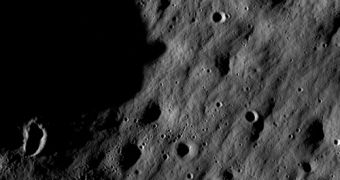Last year brought more information than ever about the Earth's satellite, mainly thanks to NASA's spacecraft. It has gathered more digital information than any other planetary mission before.
Launched on June 18, 2009, its purpose was to serve as a robotic scout for future missions and to spot any trace of icy water that may be hidden inside the polar craters. The probe has confirmed the presence of water on the moon and sent back to Earth images of the hardware left behind by Apollo astronauts, in the late 60's and 70s.
The greatest finding of the LRO was undoubtedly the grains of moon water ice revealed by NASA's Lunar Crater Observation and Sensing Satellite (LCROSS) in October 2009. Water was believed to exist on the Moon since 1940, but confirmation came only last year, when scientists announced that several missions like NASA's Cassini spacecraft, Deep Impact probe and the NASA-built Moon Mineralogy Mapper on India's Chandrayaan-1 orbiter, had revealed evidence of water molecules on the lunar surface.
However, it was LACROSS that helped discover significant amounts of water, when it crashed into a crater near the Moon's south pole. That allowed LRO and other observatories to see evidence of the ice, otherwise hidden by the crater's permanent shadows.
Michael Wargo, chief lunar scientist at the Exploration Systems Mission Directorate at NASA Headquarters in Washington, DC said that "the level of coordination required to be able to position the Lunar Reconnaissance Orbiter to pass over the impact site just 90 seconds after the impact was a spectacular achievement".
LRO and LCROSS observations of the impact mission also revealed carbon dioxide, hydrogen, carbon monoxide and sulfur dioxide, which “really provide a treasure trove of information about the formation and evolution of the solar system,” Wargo said.
The LRO has cameras that are mapping the moon in extremely high detail. Michael Wargo even said that “we can see the tracks that astronauts left behind. I don't know how anyone can see those and say we didn't go there.” he added. The spacecraft is also developing the first radar maps of the far side of the Moon, the side never seen from Earth. It is far rougher and it has significantly more craters than its near side, including one of the largest known impact craters in the solar system, the South Pole-Aitken Basin, which is roughly 1,550 miles (2,500 km) wide and 8 miles (13 km) deep.

 14 DAY TRIAL //
14 DAY TRIAL //